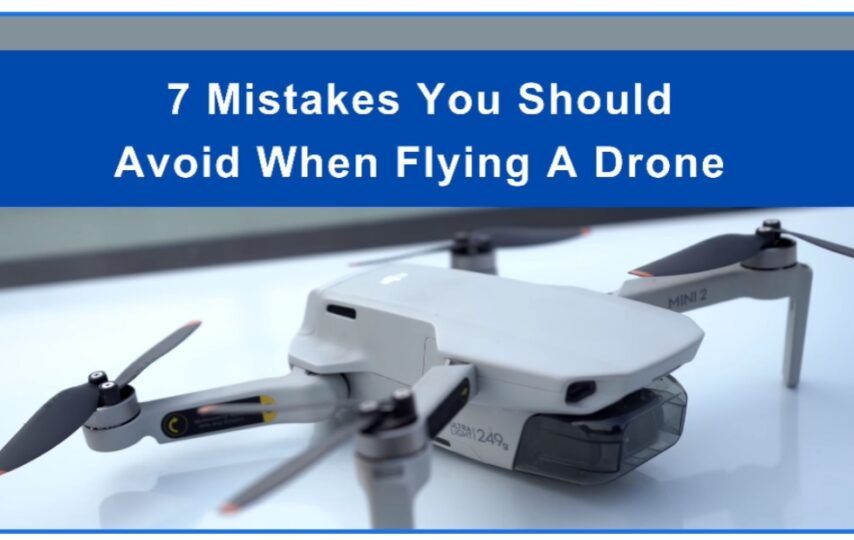When it comes to flying a drone, safety should always be a top priority. While drones are a great way to capture stunning aerial footage and explore the world from a new perspective, they can also be dangerous if not operated properly.
In fact, the Federal Aviation Administration (FAA) has reported a significant increase in drone-related incidents in recent years, many of which were caused by human error.
To ensure that you can fly your drone safely and without incident, it’s important to understand the most common mistakes that drone pilots make.
If you know how to fly a drone properly, you should still avoid these mistakes to fly your drone safely and legally.
In this blog post, we’ll explore 9 top mistakes to avoid when flying a drone. By following these tips and guidelines, you can minimize your risk of accidents or mishaps, and enjoy your drone experience to the fullest.
So whether you’re a seasoned drone pilot or just getting started, read on to learn how to fly your drone safely and responsibly.
7 Top Mistakes to Avoid When Flying a Drone
Here are the Top seven mistakes to avoid when flying a drone-
Lack of Knowledge and Preparation
Lack of knowledge and preparation is a common mistake when it comes to flying drones. To fly your drone safely and responsibly, make sure to read the user manual thoroughly and perform a pre-flight check before every flight.
By doing this, you can ensure that you’re utilizing your drone’s capabilities to the fullest and help prevent accidents caused by equipment failure or malfunction.
Ignoring Legal Regulations
Ignoring legal regulations is a serious mistake that many drone pilots make. In many countries, there are specific regulations in place regarding where and when you can fly your drone, as well as what permits or licenses may be required. It’s important to research and follow these regulations to avoid getting fined or even facing legal consequences.
For example, in the United States, the Federal Aviation Administration (FAA) has specific guidelines for flying drones, including flying below 400 feet, keeping your drone within your line of sight, and avoiding flying in restricted airspace such as near airports or military installations.
Other countries may have their own unique regulations, so it’s important to research the rules and regulations specific to your location.
It’s important to follow legal regulations when flying a drone to avoid facing fines or legal consequences. Do your research and follow the guidelines set by your country’s aviation authority to ensure that you’re flying your drone safely and legally.
Not Maintaining Visual Contact
Not maintaining visual contact with your drone is another common mistake that can lead to accidents or malfunctions. When flying your drone, it’s important to keep it within your line of sight at all times. This means not flying it too far away or behind objects that may obstruct your view.
By maintaining visual contact with your drone, you can better control its movements and respond to any unexpected changes in flight.
Additionally, it helps you avoid flying your drone into objects or people, which could cause damage or injury.
Always maintain visual contact with your drone when flying it to ensure that you have full control over its movements and can respond to any unexpected changes in flight.
By doing this, you can help prevent accidents or malfunctions and ensure that you’re flying your drone safely and responsibly.
Ignoring Weather Conditions
Ignoring weather conditions is a common mistake that can lead to accidents or malfunctions when flying a drone. Different weather conditions can affect your drone’s performance and stability, so it’s important to adjust your settings accordingly.
For example, strong winds can affect your drone’s stability and cause it to drift off course. Flying in rain or snow can also damage your drone’s electrical components and motors, which could result in a crash.
Similarly, flying in extreme heat or cold can affect battery life and cause your drone to malfunction.
By checking weather conditions before flying your drone and adjusting your settings accordingly, you can avoid accidents caused by weather-related factors.
Additionally, it’s important to know when to call off a flight altogether if conditions are too extreme or dangerous.
Ignoring weather conditions is a common mistake when flying a drone that can lead to accidents or malfunctions. Always check weather conditions and adjust your settings accordingly to ensure that you’re flying your drone safely and responsibly.
Running Out of Battery Life
Running out of battery life is another common mistake that drone pilots make. When flying your drone, it’s important to keep track of the battery life and ensure that you have enough power to safely return your drone to the ground.
To avoid running out of battery life, it’s recommended to carry extra batteries or charging equipment with you.
This will allow you to quickly and easily replace a drained battery with a fully charged one, ensuring that you can continue flying your drone without interruption.
It’s important to be aware of your drone’s flight time and adjust your flight plan accordingly.
For example, if you know that your drone has a flight time of 20 minutes, it’s best to plan your flight route so that you can safely return your drone to the ground before the battery runs out.
Running out of battery life is a common mistake when flying a drone that can lead to accidents or malfunctions.
Always keep track of your drone’s battery life and carry extra batteries or charging equipment to avoid interruption. By doing this, you can ensure that you’re flying your drone safely and responsibly.
Over Reliance on Autonomous Features
Over-reliance on autonomous features is a common mistake that can lead to accidents or malfunctions when flying a drone.
While many drones come equipped with features such as GPS, obstacle avoidance, and automatic return to home, it’s important to remember that these features are not foolproof.
For example, GPS can be affected by environmental factors such as interference or signal loss, which can cause your drone to drift off course.
Obstacle avoidance sensors may not detect all obstacles, and automatic return to home may not work properly if the drone is not within range or encounters other issues.
To avoid over-reliance on autonomous features, it’s important to learn how to fly your drone manually and be prepared to take control if necessary.
Always be aware of your surroundings and fly your drone in an open and clear space to minimize the risk of collisions.
Over-reliance on autonomous features is a common mistake when flying a drone that can lead to accidents or malfunctions.
Flying too Close to People or Property
Flying your drone too close to people or property can be dangerous and even illegal in some cases. It’s important to respect the privacy and personal space of others when flying your drone, and to maintain a safe distance at all times.
Not only can flying too close to people or property result in damage or injury, but it can also invade their privacy and cause legal consequences.
To avoid this mistake, always be aware of your surroundings and respect any private property or no-fly zones in your area.
It’s important to obtain necessary permits or licenses if required by law. By doing this, you can ensure that you’re flying your drone safely and responsibly.
Conclusion
In conclusion, to fly your drone safely and responsibly, it’s essential to avoid common mistakes such as lack of knowledge and preparation, ignoring legal regulations, not maintaining visual contact, ignoring weather conditions, running out of battery life, over-reliance on autonomous features, and flying too close to people or property.
By following proper safety procedures, respecting the privacy and personal space of others, and staying informed about regulations in your area, you can enjoy your drone experience to the fullest while minimizing any potential risks or negative consequences.








